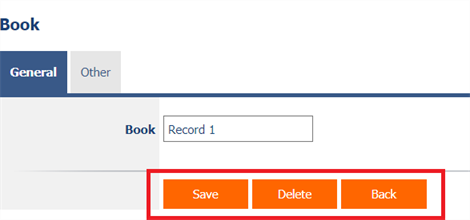Manual in PDF format
1. Basic information
1.1. Description of the control

Each edit form automatically contains an “ActionButtons” control, which consists of three basic buttons needed to work with the form – “Save”, “Delete” and “Back”.
2. List of tabs in the control settings dialog
- General – Setting general properties
- Save – Save button settings
- Delete – “Delete” button settings
- Back – “Back” button settings
2.1. “General” tab

2.1.1. Options
- Hide “Save” button
- Checking this box determines whether the “Save” button should be hidden in the edit form.
- Hide “Delete” button
- Checking this box determines whether the “Delete” button should be hidden in the edit form.
- Hide “Back” button
- Checking this box determines whether the “Back” button should be hidden in the edit form.
- Show “Save and continue editing” button
- Checking this box determines whether the “Save and continue editing” button should be displayed in the edit form.
- Show “Save and new” button
- Checking this box determines whether the “Save and New” button should be displayed in the edit form.
- The button text can be set to custom.
2.1.2. OnAfterOpen
- A script that is executed when the record is opened in an edit form.
2.2. “Save” tab

2.2.1. JavaScript
- The name of the function without a semicolon at the end, which starts when the “Save” button is pressed.
- If the return value of the function is “true”, the server script “OnBeforeSave” is executed.
- If the return value of the function is “false”, the server script “OnBeforeSave” will not be executed and the record will not be saved.
2.2.2. OnBeforeSave
- A script that is executed before the record is saved to the database.
2.2.3. OnAfterSave
- A script that is executed after the record is saved to the database.
2.2.4. OnBeforeOpen
- A script that is executed before a new record is opened in the edit form.
- The “OnBeforeOpen” script is executed after pressing the “Save and new” button in the edit form.
2.3. “Delete” tab

2.3.1. JavaScript
- The name of the function without a semicolon at the end, which starts when the “Delete” button is pressed.
- If the return value of the function is “true”, the server script “OnBeforeDelete” is executed.
- If the return value of the function is “false”, the server script “OnBeforeDelete” will not be executed and the record will not be deleted.
2.3.2. Options
- Always allow deleting to the owner or co-owner of the record
- Checking this box determines whether the record owner or co-owner should be allowed to delete the record, regardless of the existence of other controls on the form to which the record owner or co-owner does not have the right.
2.3.3. OnBeforeDelete
- A script that is executed before deleting a record from the database.
2.3.4. OnAfterDelete
- A script that is executed after deleting a record from the database.
2.4. “Back” tab

2.4.1. JavaScript
- The name of the function without a semicolon at the end, which starts when the “Back” button is pressed.
- If the return value of the function is “true”, the user is redirected back to the place from which the edit form with the currently open record was called.
- If the return value of the function is “false”, the user will not be redirected back.
3. Examples
3.1. Javascript functions
- attachEvent2(window, 'load', function() { var o = el('btSave'); if (o != null) o.style.display = 'none'; });
- attachEvent2(window, 'load', function() { var o = el('btDelete'); if (o != null) o.style.display = 'none'; });
- attachEvent2(window, 'load', function() { var o = el('btBack'); if (o != null) o.style.display = 'none'; });
